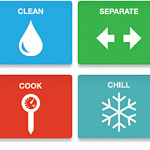 September is National Food Safety Month. However, food safety should be practiced every day of the year and for every meal and/or snack. We live in a busy society. We are always in a rush to do and to go to whatever we have planned.
September is National Food Safety Month. However, food safety should be practiced every day of the year and for every meal and/or snack. We live in a busy society. We are always in a rush to do and to go to whatever we have planned.
When it comes to our food, we need to make the time to observe steps to food safety. Food safety will decrease the opportunity for food borne illness. The steps are as follows:
- Clean – everything that touches the food. This includes hands, utensils, surfaces, and foods – fruits, vegetables, but not meats or eggs. Wash hands in hot water and soap for at least 20 seconds. Bacteria can get on cutting boards and utensils. Rinse fresh fruits and vegetables under running tap water, including those with skins and rinds that are not eaten. Rub firm-skin fruits and vegetables under running tap water or scrub with a clean vegetable brush while rinsing with running tap water.
- Separate – surfaces used for raw meats and eggs from other foods or surfaces when shopping, storing, preparing, and cooking. This will prevent cross-contamination.
- Cook – food at the correct temperature by using a food thermometer (see the chart below). The danger temperature zone is 400 to 1400 Fahrenheit. This is when bacteria rapidly grows.
- Chill – Refrigerate perishable foods within two hours. Never thaw or marinate foods on the kitchen counter.
After you remove meat from a grill, oven, or other heat source, allow it to rest for the specified amount of time. During the rest time, its temperature remains constant or continues to rise, which destroys harmful germs.
| Category | Food | Temperature (°F) | Rest Time |
| Ground Meat & Meat Mixtures | Beef, Pork, Veal, Lamb | 160 | None |
| Turkey, Chicken | 165 | None | |
| Fresh Beef, Veal, Lamb | Steaks, roasts, chops | 145 | 3 minutes |
| Poultry | Chicken & Turkey, whole | 165 | None |
| Poultry breasts, roasts | 165 | None | |
| Poultry thighs, legs, wings | 165 | None | |
| Duck & Goose | 165 | None | |
| Stuffing (cooked alone or in bird) | 165 | None | |
| Pork and Ham | Fresh pork | 145 | 3 minutes |
| Fresh ham (raw) | 145 | 3 minutes | |
| Precooked ham (to reheat) | 140 | None | |
| Eggs & Egg Dishes | Eggs | Cook until yolk and white are firm | None |
| Egg dishes | 160 | None | |
| Leftovers & Casseroles | Leftovers | 165 | None |
| Casseroles | 165 | None | |
| Seafood | Fin Fish | 145 or cook until flesh is opaque and separates easily with a fork. | None |
| Shrimp, lobster, and crabs | Cook until flesh is pearly and opaque. | None | |
| Clams, oysters, and mussels | Cook until shells open during cooking. | None | |
| Scallops | Cook until flesh is milky white or opaque and firm. | None |
Food is for the nourishment of our body, not to make us sick. Take the time to clean, separate, cook, and chill foods to avoid food borne illness. For more detailed information and videos, visit www.foodsafety.gov and www.fightbac.org.
Sources: www.foodsafety.gov; www.fightbac.org
- Diabetes - November 16, 2016
- September is Food Safety Month - August 28, 2016
- It’s Picnic Time - July 17, 2016
